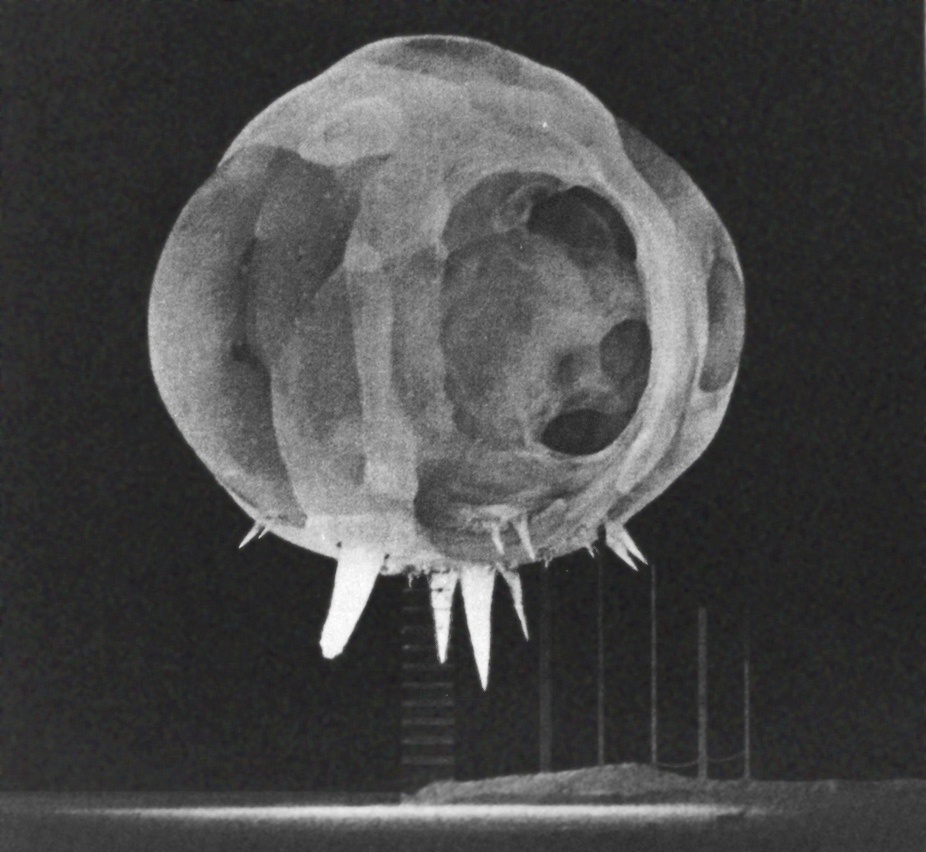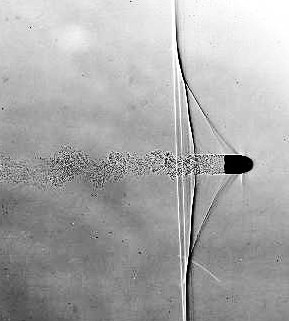
Nuclear explosion captured by Edgerton’s Rapatronic camera (U.S. Air Force 1352nd Photographic Group)
On April 6, 1903, Harold Eugene “Doc” Edgerton, professor for electrical engineering at the Massachussetts Institut of Technology was born.He is largely credited with transforming the stroboscope from an obscure laboratory instrument into a common device. He also was deeply involved with the development of sonar and deep-sea photography, and his equipment was used by Jacques Cousteau in searches for shipwrecks and even the Loch Ness monster.
Harold Eugene Edgerton – Early Years
Edgerton was born in Fremont, Nebraska, the first of Frank and Mary Edgerton’s three children. His father was a lawyer, journalist, author and orator, as well as a descendant of Governor William Bradford of the Plymouth Colony and a passenger on the Mayflower. Harold grew up in Aurora, Nebraska and became interested in photography through his uncle, Ralph Edgerton, a studio photographer, who taught Harold how to take, develop, and print pictures.
Edgerton earned a bachelor’s degree in electrical engineering from the University of Nebraska in 1925 and received master’s (1927) and doctoral (1931) degrees in the same field from the Massachusetts Institute of Technology (MIT) in Cambridge. Edgerton used stroboscopes to study synchronous motors for his doctoral thesis, which included a high-speed motion picture of a motor in motion, made with a mercury-arc stroboscope. He credited Charles Stark Draper with inspiring him to photograph everyday objects using electronic flash; the first was a stream of water coming out of a faucet. He taught at MIT from 1928, becoming a full professor there in 1948.
How to Slow Down Time
Though taking a “still” picture of a rapidly moving object had been accomplished by William Henry Fox Talbot in 1851 and had been improved upon by many others, Edgerton was not only the first to substitute a control circuit for a tube or lamp, but the first to make high-speed flash photography practical. [4,5] In 1926, as a graduate student, Edgerton began to experiment with flash tubes. He developed a tube using xenon gas that could produce high-intensity bursts of light as short as 1/1,000,000 second. Edgerton’s tube remains the basic flash device used in still photography. The xenon flash could also emit repeated bursts of light at regular and very brief intervals and was thus an ideal stroboscope. With his new flash Edgerton was able to photograph the action of such things as drops of milk falling into a saucer, a tennis racket hitting a ball, and bullets hitting a steel plate or traveling at speeds of up to 900 m per second. The resulting images often possessed artistic beauty in addition to their value to industry and science.
The Stroboscobe
Perhaps the most famous early use of the stroboscope was in a lawsuit between the Lever Brothers and Procter & Gamble on their competitive methods of making soap powder. High-speed, stroboscopic motion pictures provided visual proof that Lever Brothers’ methods were different from Procter & Gamble’s and the suit was dropped.[3] During the late 1930s, Edgerton spent more and more time outside the laboratory. His photographs of stage shows, like the Follies, and sports events captured the imagination of news photographers.

Photo taken during a “freshman seminar” conducted by Harold Edgerton at MIT, using his lab’s equipment.
Science as Art
In 1937 Edgerton began a lifelong association with photographer Gjon Mili, who used stroboscopic equipment, in particular, multiple studio electronic flash units, to produce strikingly beautiful photographs, many of which appeared in Life Magazine. When taking multiflash photographs this strobe light equipment could flash up to 120 times a second. Edgerton teamed up with Kenneth J. Germeshausen to do consulting work with different industrial clients. Together with Herbert Grier they founded “Edgerton, Germeshausen, and Grier” (EG&G) in 1947, which should become a prime contractor for the Atomic Energy Commission and had a major role in photographing and recording nuclear tests for the United States.
The Nuclear Tests
For the nuclear tests, Edgerton and his colleagues soon realized that to take still pictures of such a huge release of light, they would have to make exposures of shorter duration than had even been imagined. To solve this problem, they invented a camera they called the “rapatronic” (for rapid electronic). When light from the bomb hit the photocell in the camera, it triggered a mechanism that opened and then cut off the exposure in as little as two microseconds.[3]
The Life Aquatic
In 1952, the National Geographic Society asked Edgerton to join them in underwater exploration, and Doc meet the leader of the expeditions, Jacques-Yves Cousteau who became a life-long friend.[6] Edgerton worked with the undersea explorer Jacques Cousteau, by first providing him with custom designed underwater photographic equipment featuring electronic flash, and then by developing side-scan sonar technology, used to scan the sea floor for wrecks, by which they discovered the Britannic. Edgerton participated in the discovery of the American Civil War battleship USS Monitor. While working with Cousteau, he acquired the nickname he is still known by in photographic circles, “Papa Flash”.
The Boomer
In 1961, Edgerton invented the “boomer”, i.e. an acoustic device similar to the pinger that could locate objects lying on and beneath the ocean floor and deliver seismic provides of them. He used the boomer to find an H-bomb off the coast of Spain, search for the ancient Greek city of Helice (submerged about 373 B.C.), and map various ocean trenches.
Death
Edgerton continued to be active at his university after he retired and died very suddenly at the age of 86 while attending the MIT Faculty Club. He is buried in Mount Auburn Cemetery in Cambridge, Massachusetts.
Huge Nuclear Fireball in slow motion, Operation Teapot – Turk 1955, [8]
References and Further Reading:
- [1] J. Kim Vandiver, P. Kennedy: Harold Eugene Edgerton, A Biographical Memoir, National Academy of Sciences.
- [2] Harold E. Edgerton at BritannicaOnline
- [3] Harold “Doc” Edgerton, at Edgerton Digital Collections.org
- [4] Photographic Pioneer Henry Fox Talbot, SciHi Blog
- [5] The Undersea World of Jacques Cousteau, SciHI Blog
- [6] The Edgerton Digital Collections website by the MIT Museum with thousands of photographs and scanned notebooks.
- [7] Harold Eugene Edgerton at Wikidata
- [8] Huge Nuclear Fireball in slow motion, Operation Teapot – Turk 1955, The Centralnuclear @ youtube
- [9] Gray, Paul E. (April 1991). “Obituary: Harold E. Edgerton”. Physics Today. 44 (4): 126–128.
- [10] Grundberg, Andy (January 5, 1990). “H. E. Edgerton, 86, Dies. Invented Electronic Flash”. The New York Times.
- [11] Timeline of Photographic Pioneers, via DBpedia and Wikidata






Pingback: Whewell’s Gazette: Vol. #43 | Whewell's Ghost